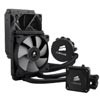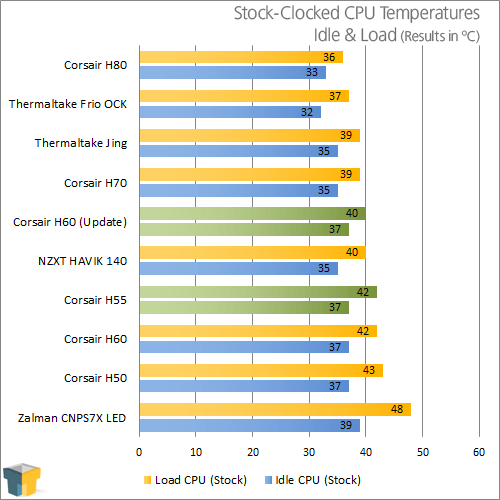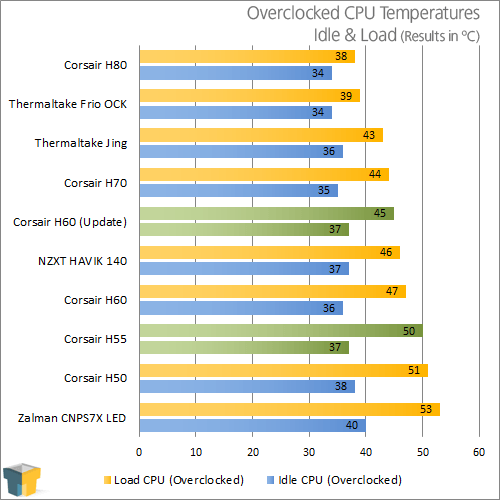- Qualcomm Launches Snapdragon 4 Gen 2 Mobile Platform
- AMD Launches Ryzen PRO 7000 Series Mobile & Desktop Platform
- Intel Launches Sleek Single-Slot Arc Pro A60 Workstation Graphics Card
- NVIDIA Announces Latest Ada Lovelace Additions: GeForce RTX 4060 Ti & RTX 4060
- Maxon Redshift With AMD Radeon GPU Rendering Support Now Available
Keeping it Cool: Corsair Hydro H60 Update and H55 Review

Corsair has long been offering some of the most attractive all-in-one liquid cooling options on the market with its Hydra series, but it’s been a while since the entry-level models have seen much of an update. That changed late last month, though, with the release of the brand-new H55 and revamped H60. Let’s check them out.
Page 2 – Installation, Testing & Final Thoughts
Both coolers install more or less the same way as the previous models did (H50 installation / H60 installation), but with one exception. The block and pump cover of the H60 is magnetic, which allows the mounting bracket to snap onto it, making installation even easier as it doesn’t move around.
Corsair suggests that the fan on its Hydro series coolers be used as an intake, meaning the internal airflow of the case should be reversed if using a front-to-back layout. This setup allows cool air to be pulled in from outside instead of pushing out air that has already been warmed internally.
Seeing how we also test air coolers in the same system, this simply isn’t an option, so we’re going to stick with the standard setup as done in past reviews for consistency’s sake.


Let’s start with the H55 again as we look at the results. This capable little cooler was able to best the H50 by a single degree, which isn’t bad at all for a budget offering. It kept the temperature well within Intel’s thermal limits and should allow for loads of extra overclocking headroom.
Its bigger brother however was able to beat the original H60 by two degrees across the board. This may not seem like much, but the H60 only fell short of the H70 by a single degree while overclocked under full load even though the H70 has a thicker radiator and an extra fan.
Whether mild or medium, Corsair seems to have just about every price-point captured, but there are a few things to point out as we wrap this up.
Final Thoughts
First off, Corsair should be commended for continuing to switch out the rigid hoses, which I have always felt were a bit too tough to route. The new hoses are a dream to work with and should allow users to mount the radiator in more locations than before with very little trouble.
My only gripe is with the H55 and the fact that it uses the “ring” mounting method. Compared to what I like to call the “four corner” method found on the H60, installing the H55 could prove to be tough for a novice. Unfortunately without a redesign of the mounting hardware, block, pump and housing, this mounting method is here to stay.
With that said, if after reading this you’ve decided to jump into the liquid cooling pool, the H55 will set you back ~$69 US and the new H60 is selling for ~$76 US at a popular online retailer.
Even though the design changes listed in this review are more subtle than say, an entire overhaul of a CPU architecture or a 200mm monster fan stuck to the side of a case, it’s nice to see there is still some evolutionary innovation happening and it’s because of this innovation that we’re awarding both coolers our Editor’s Choice Award.

Corsair Hydro H55 Liquid Cooler
Corsair Hydro H60 Liquid Cooler
As a separate note, we’re in the process of overhauling our cooler test system and, if everything pans out, it should be ready to roll in a month or two.
Some readers have called us out for not using a CPU that’s able to really push the coolers we test, so this change will give us a better idea of what they can truly handle by pairing them with a chip that is more indicative of what enthusiasts are likely to use and the heat they are generating.
We’ll be testing several past coolers including the H55 and H60 along with a few new ones in an effort to rebuild our temperature list, so stay tuned.
Support our efforts! With ad revenue at an all-time low for written websites, we're relying more than ever on reader support to help us continue putting so much effort into this type of content. You can support us by becoming a Patron, or by using our Amazon shopping affiliate links listed through our articles. Thanks for your support!




